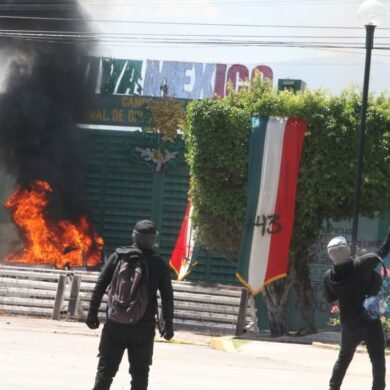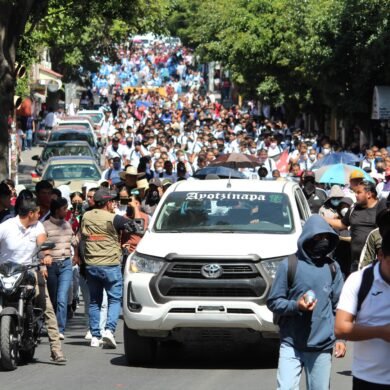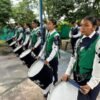Marlén Castro, Vania Pigeonutt, Margena de la O, Jacob Morales
Traducción: Sergi Rodríguez
English Version
The student population of the Normal Rural Raúl Isidro Burgos, of Ayotzinapa, where 43 students disappeared five years ago, has been surrounded by police surveillance and infiltration, almost immediately after its creation in 1929.
To live as an infiltrated from whom? It could be the Army, the CISEN, the political parties, the Ministry of Education, according to the graduates who studied thinking they lived with the enemy. In the last eight years they have also been surrounded by organized crime, their narrations indicate.
Amapola Periodismo interviewed graduates of 17 generations, which are about 59 years of academic, student and political activism life. They reveal a common thread: infiltration as a state strategy to divide the social movement and disappear the institution that survives along with 15 other rural normal school, and is one of the few options for free education in Mexico.
The recommendation issued by the National Human Rights Commission (CNDH), in November 2018, established the infiltration of an organized crime group among students as a reason for the possible aggression against the students. Amapola Periodismo pulled from this thread: infiltration, and found out evidence that this would also be a modality employed by the State.
We divide the testimonies into three groups: the three initials or historical ones from the 50s, those that occurred after the 70’s guerrillas, which were the 80s, 90’s, and the testimonies that start after the year 2000.
For historical graduates, the infiltration began after the mass movement of 1960, which succeeded in overthrowing former governor Raúl Caballero Aburto and the autonomy of the Guerrero College, which would become the Autonomous University of Guerrero (UAGro); and, during the beginning of the guerrilla movements of the end of that decade.
The three characters talk about how important the former Ayotzinapa student and former guerrilla fighter Lucio Cabañas was for the political training of students and how he becomes, first, a student leader and then a regional leader. Later he will lead the Party of the Poor, which will be a subversive group.
They emphasize Lucio’s social conscience and how he directed the students to get involved in the struggles of that time, such as the movement for university autonomy. He established the tradition of study circles, which consist of reading authors who talk about socialism and class struggle, such as Marx.
César Núñez, who was part of the 1955-1960 generation, explains that: “Ayotzinapa has an important role in the political struggle of Guerrero since 1960. The students, headed by Lucio, who in that year was leader of the Peasants Student Federation Socialist of Mexico (FECSM), participated in the anticaballerista movement calling for the autonomy of the University. The participation of him and the boys was fundamental”.
He says that after that it began a process of closing the rural normal schools in the country, which were the main refuge of the rural people, of the poor. He coincided as a Cabañas classmate, but did not join the armed conflict, Núñez rather formed as a political cadre and led the National Regeneration Movement (Morena) in Guerrero, the current president’s party, Andrés Manuel López Obrador.
For Núñez, the seal and orientation of rural normal education, influenced by its cardenista origin, went to the popular class. “The rural normalist had an identity with the people and gave everything for education. We had a deep discipline in that sense”.
In this period, Adolfo Ruiz Cortines and Adolfo López Mateos governed in Mexico. During those years in the country there was an important movement of railroad workers for wage increase and the recovery of unionism.
The Revolutionary Magisterial Movement (MRM) was also born, now considered the beginnings of the magisterial dissent in the country, in which the Guerrero professor Othón Salazar had the most important participation.
Another of our interviewees is Félix Bautista, of the 1956-1962 generation. He graduated with Cabañas. In his opinion, after the active participation of Ayotzinapa, in the 1960 movement that left 17 people killed, and after the decision of his partner Lucio to take up arms, a counterinsurgency era began and the infiltration began in his normal.
In his period he was general secretary of the normal –the most important position of a student, within the political organization of the school- Julián Castillo Navarrete, a cousin of Lucio. He took his place when Lucio was named general secretary of the FECSM, an agency that represented his school nationwide.
“Political formation for us, in charge before as now of the Committee of Political and Ideological Organization (COPI), was as important as the academic formation.
There was an important moment outside of Mexico. The Cuban revolution began and we received the information of what was happening. Also of what was happening in China and in the countries of the Soviet Union, everything that had to do with its economic, scientific and cultural development”, he shares.
Ayotzinapa, says Bautista, now 78, was always involved in state and country policy issues. “In those days the political or police infiltration of the State in Ayotzinapa was not like now that, it is known, could register as students. The State had full political control with Caballero Aburto commanding, so there was no need for the police or informants to enter the Normal”.
The role of police officers, especially the Judicial Police, was that of informants. They were very handmade. They dressed in guayaberas and showed their weapon. They were seen in public squares, in rallies, in marches. That was his official strategy at the time. No sophistication Security teams attending public events reported what was happening: who spoke and what they were saying. It was used a lot.
The infiltration in Ayotzinapa developed in the years that the insurgency in Guerrero emerged, which has had different periods, first with Lucio Cabañas Barrientos and Genaro Vázquez Rojas, and then with the Popular Revolutionary Army (EPR) and the Revolutionary Army of the Insurgent People (ERPI). All this happened since 1960, he emphasizes.
Also from that generation, Arturo Miranda believes that the government always tried to infiltrate Ayotzinapa. There is a history of 1941, when they expelled the entire student leadership and some teachers accused of aggravating the national symbols. Jail was their punishment.
In 2000 he was director of the Normal Rural Emiliano Zapata form Amilcingo, Morelos, another one of the schools of the Ayotzinapa type that survives until now, in this one only women study. During that year he realized that every time there was an internal problem, police officers monitored the Normal.
“I know what I say. The military intelligence or government agents searched for me to inform them of what was happening. ‘They didn’t send me here to be an ear, I’m on a school principal appointment, you investigate that’”, he told them.
In the case of Morelos, he detected some girls using cell phones very discreetly. «In those years, not everyone could have a cell phone, one, for a matter of money and another, because the signal was complicated.»
Another moment in which he confirmed great interest of the government in the rural normal school was after the murder of the Ayotzinapa normalists, Gabriel Echeverría de Jesús and Jorge Alexis Herrera Pino, which occurred in Chilpancingo, on the Autopista del Sol, on December 12, 2011.
“The murder of these normalists is the first that occurs in the government of Ángel Aguirre Rivero. This governor did not even finish his term (2011-2015). He is forced to retire in 2014, after the night of Iguala when they killed three more normalists and disappeared another 43”.
For Miranda, Aguirre Rivero is one of the current political figures that promoted the closure of Ayotzinapa. He did it after the murder on the Autopista del Sol, with an intense campaign of hatred against the normalists. From that date, it marks a before and after for Ayotzinapa.
The students of this Normal that represents the Mexican rural school that strengthened President Lázaro Cárdenas, have lived with the possibility that the classmate is the Trojan horse that seeks to undermine his organization. All the stories agree that during all these years they have learned to deal with this strategy: for none of them it is a secret that one of their classmates can be a traitor.
From the first years of its operation, the normalists had to expel fellow suspects, and close the doors to a leftist leader; perform double activities, protect each other among members of the Committee, all this with the intention of confusing their enemies.
In recent generations they expelled students with ties to the PRI on suspicion of belonging to organized crime. This is the life of the Ayotzinapa normalist, who has always known the background of his evil: the disappearance of rural normalism.
José Ángel Román Espinoza of the 2003-2007 generation, who was general secretary of 2005-2006, told how they stole the brain of a computer with all the information about the student structure, the portfolios that were there, the functions of each one, how to they chose the members, how decisions were made.
“We sat down to analyze how the CPU was stolen and we concluded that it was an afternoon when the SEG called us to a meeting to Chilpancingo. The next year that we graduated, in 2008, the government opened two other degrees in the Normal, the Bachelor of Bilingual Education and the Bachelor of Physical Education, on its own, without the student base asking them to open them”, he details.
Another graduate, from the 2013 generation, tells how his Committee decided to expel three fourth-year students. “We realized that they had a relation with Silvia Ojeda, coordinator of advisors to the SEG, and with the secretary of that time, José Luis González de la Vega, and also with Héctor Vicario, who was deputy for the PRI, and always close to former governor Rubén Figueroa Alcocer”.
Those boys who were expelled were opposed to the actions of the Committee, challenged their indications, drank alcohol inside the school and sold drugs, it was even known that they were armed, at least one of them was seen carrying a nine millimeter pistol.
A survey of 10 questions was applied to each graduate, whose answers weave these testimonies that reflect the actors behind the surveillance and infiltration of Ayotzinapa, almost all directly or indirectly associated with the institutions.
We want to clarify to our readers, that from the generations of the seventies we did not get any testimony, but we did confirm that it was the hardest time for police surveillance in the Normal, through other graduates.
Many of our interviewees decided not to declare with their name, and this does not imply that there is anonymity, but confidentiality: as a team we are certain that they were part of the Ayotzinapa student structure, and their voices are important to explain the infiltration; however, in a context of complex violence, they prefer not to reveal their identity.
With their stories, graduates allow us to enter the bowels of a normal that has been repressed almost since its creation. Open the doors to their political organization, to understand the nemesis of the conflict in a revealing timeline: almost in no year since its creation they have stopped sailing alongside the organization and the academy.
An interviewed generation began their education, in full triumph of President López Obrador. In a state context of social tension. Three years after the PRI government, Héctor Astudillo Flores, and before the triumph of the PRD Erika Alcaraz, identified as friend of the deputy Bernardo Ortega Jiménez, whose family is accused of forming the strongest organized local crime group in the municipalities: Zitlala, José Joaquín Herrera, Chilapa and Tixtla, where several normalists are from.
The 17 testimonies with which we construct our hypothesis, can be consulted widely in a single way in our microsite.










